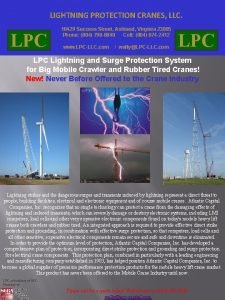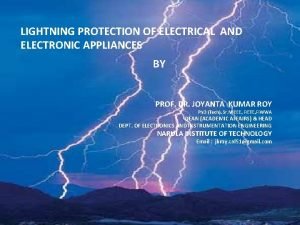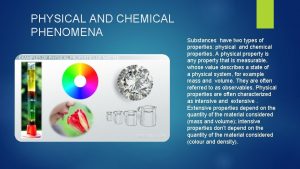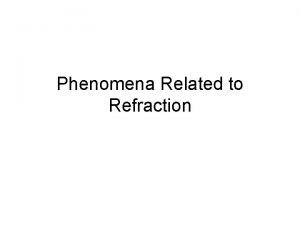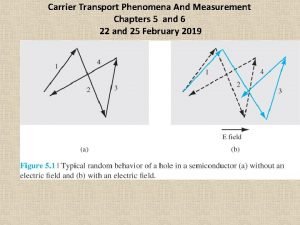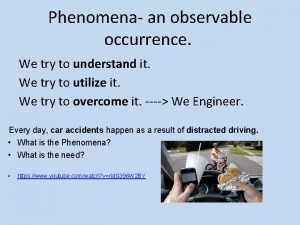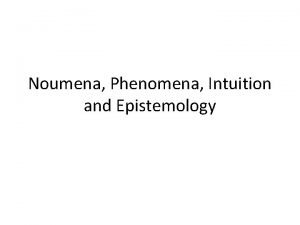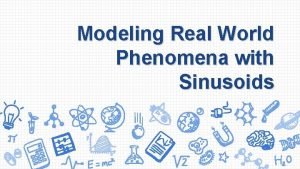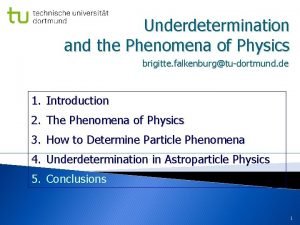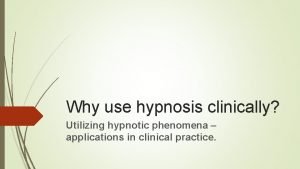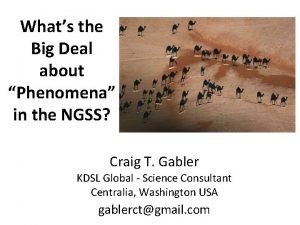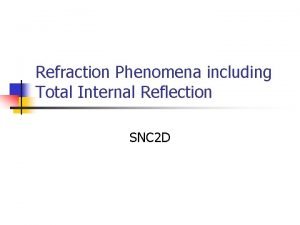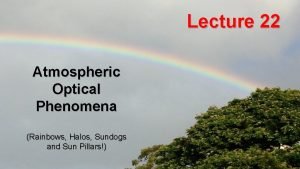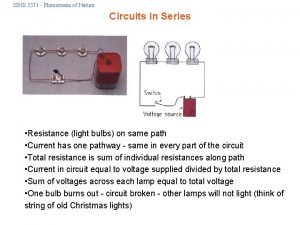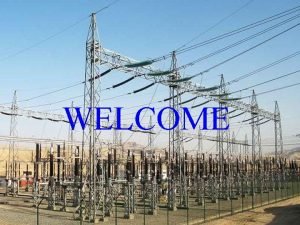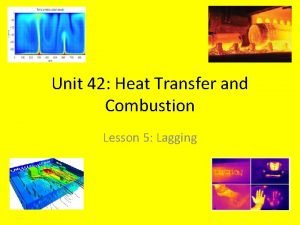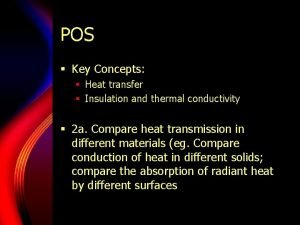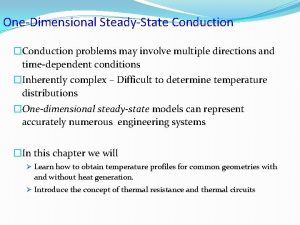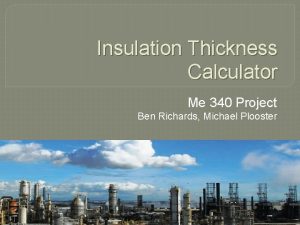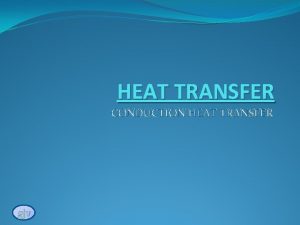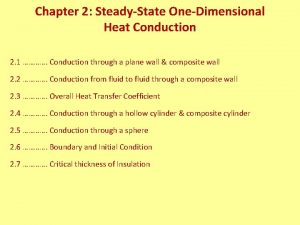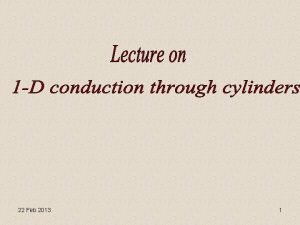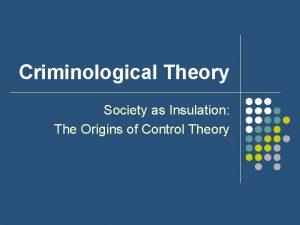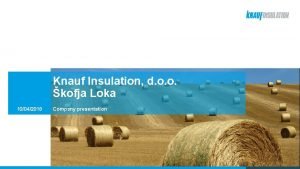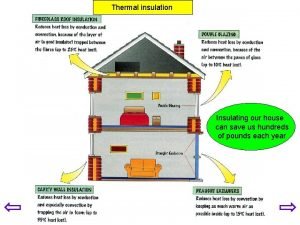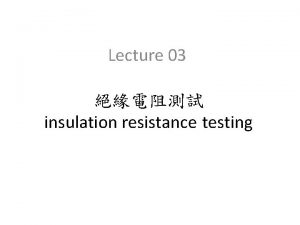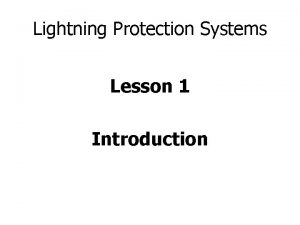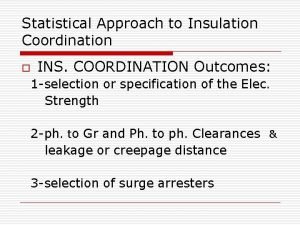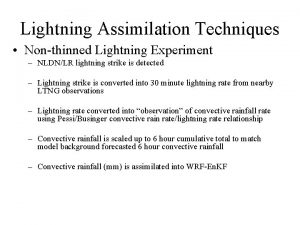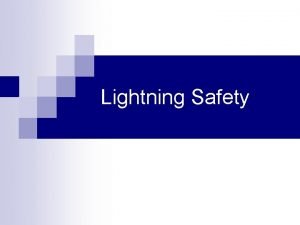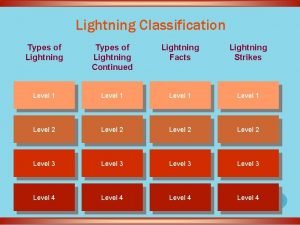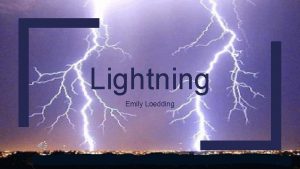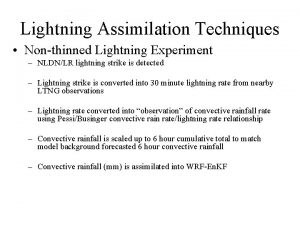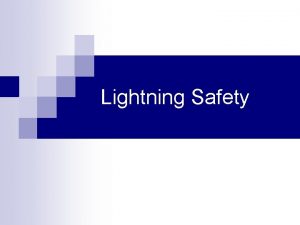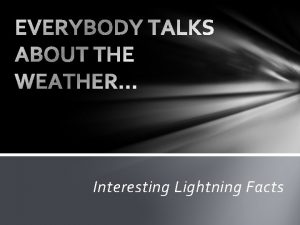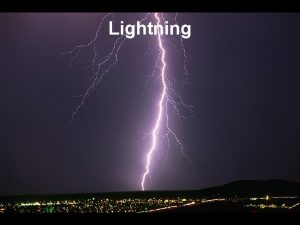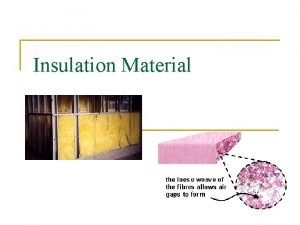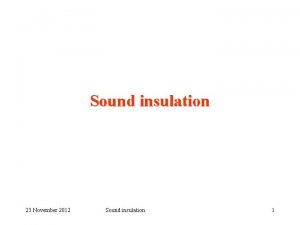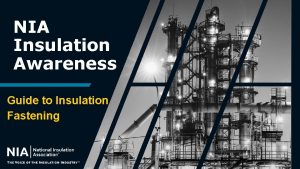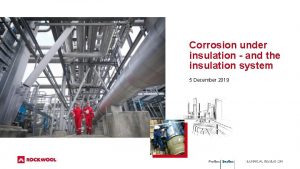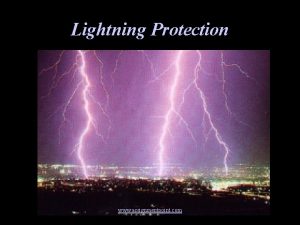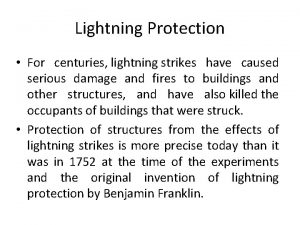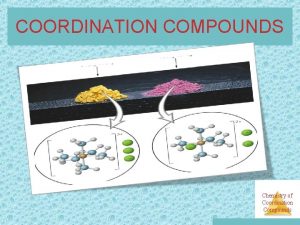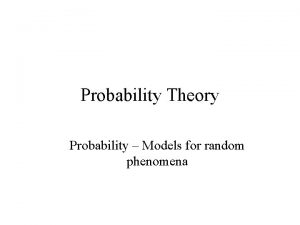CHAPTER 6 Lightning Protection Insulation Coordination LIGHTNING PHENOMENA






















































- Slides: 54

CHAPTER 6 Lightning, Protection & Insulation Coordination • LIGHTNING PHENOMENA • STROKE FORMATION • LIGHTNING PARAMETER • EMPIRICAL DESIGN METHODS • ELECTROGEOMETRIC MODEL (EGM) • INSULATION LEVEL 1

Lightning Phenomena Lightning require the formation of certain type of clouds to be presence in their generation. This type of clouds is known as cumulonimbus clouds more specifically is the lightning generating type.

Lightning Phenomena Based on Ice Splinter Theory, moistures in the atmosphere combining with precipitating particles which are suspended in air are force higher up into the altitude by updraft. Every km going higher up in altitude there is decreased about 0. 4 o. C. So the moistures experienced super cooling and formed crystalline ice with double layered ice structures. During the process of super cooling, H 2 O undergo ionization break up into anions (H+) and cations (OH-). The existences of temperature gradient in the super cooling moisture structure allowing the migration of H+ ions and OH- ions. However due to lighter weight of H+ ions they become more mobile allowing them to move towards the outer shell, leaving the heavier ions OH- in the inner shell of the ice structures

Lightning Phenomena Figure (a) show the physical relationship of moisture, precipitating particle with the updraft pushing the matters mentioned high in the latitude

Lightning Phenomena Figure (b) show the formation of ice crystal with two -layered structure of positively charged externally and negative charged internally

Lightning Phenomena Figure (c) : Splintering process of the ice crystal to form minute splinters pushing the positive charged splinters higher up in the altitude

Lightning Phenomena • Figure d shows the lower part of a thundercloud is usually negatively charged. The upper portion area is usually positively charged. Lightning from the negatively charged area of the cloud generally carries a negative charge to Earth and is called a negative flash. A discharge from a positivelycharged area to Earth produces a positive flash

Stroke Formation There a number of different types of lightning strokes. These include strokes within clouds, strokes between separate clouds, strokes to tall structures, and strokes that terminate on the ground. The positive and negative strokes terminating on the ground are the types of most interest in designing shielding systems. 8

Stroke Formation v. Stepped Leaders The actual stroke development occurs in a two-step process. The first step is ionization of the air surrounding the charge center and the development of stepped leaders which propagate charge from the cloud into the air. Current magnitudes associated with stepped leaders are small (in the order of 100 A) in comparison with the final stroke current. The stepped leaders progress in a random direction in discrete steps from 10 to 80 m in length. 9

Stroke Formation 10

Stroke Formation v Return Stroke The second step in the development of a lightning stroke is the return stroke. The return stroke is the extremely bright streamer that propagates upward from the earth to the cloud following the same path as the main channel of the downward stepped leader. This return stroke is the actual flow of stroke current that has a median value of about 24 000 A. The velocity of the return stroke propagation is about 10% the speed of light. 11

Stroke Formation 12

Lightning Parameters Strike distance 2. Stroke current magnitude 3. Keraunic Level 4. Ground Flash Density 1. 13

Correlations between Return stroke current magnitude and strike distance (length of the last stepped leader) are interrelated. A number of equations have been proposed for determining the striking distance. S is the strike distance to ground in (m) I is the return stroke current in (k. A) The equation stroke current, 14

Keraunic Level • Keraunic level is defined as the average number of thunderstorm days or hours for a given locality. • A daily keraunic level is called a thunderstormday and is the average number of days per year on which thunder will be heard during a 24 hours period. • The average annual keraunic level for locations can be determined by referring to keraunic maps. 15

Annual frequency of thunderstorm days in the world 16

Ground Flash Density • Ground flash density (GFD) is defined as the average number of strokes per unit area per unit time at a particular location. • It is usually assumed that the GFD to earth, a substation, or a transmission or distribution line is roughly proportional to the keraunic level at the locality. 17

Ground Flash Density If thunderstorm days are to be used as a basis, it is suggested that the following equation be used: - Where ◦ Nk is the number of flashes to earth per square kilometer per year ◦ Nm is the number of flashes to earth per square mile per year ◦ Td is the average annual keraunic level, thunderstorm days 18

The mapping of the lightning ground flash density of Peninsula Malaysia(courtesy of TNBR) 19

EMPIRICAL DESIGN METHODS Two classical design methods have historically been employed to protect substations form direct lightning strokes: - ◦ Fixed angles ◦ Empirical curves The two methods have generally provided acceptable protection 20

Fixed Angles The fixed-angle design method uses vertical angles to determine: • the number • position • height of shielding wires or masts The angles used are determined by: - • the degree of lightning exposure • the importance of the substation being protected • the physical area occupied by the substation • The value of the angle alpha that is commonly used is 45°. Both 30° and 45° are widely used for angle beta. 21

Fixed Angles Fixed angles for shielding wires 22

Fixed Angles Fixed angles for mast 23

Empirical curves From field studies of lightning and laboratory model tests, empirical curves have been developed to determine number, position, and height of shielding wires and masts (Wagner et al. , 1941; Wagner, 1942; Wagner, Mc. Cann, Beck, 1941). The curves were developed for shielding failure rates of 0. 1, 1. 0, 5. 0, 10, and 15%. A failure rate of 0. 1% is commonly used in design. The empirical curve method has also been referred to as the Wagner method. 24

Figure (a) Figure (b) Figure (a) Single lightning mast protecting single ring of object — 0. 1% exposure. Height of mast above protected object, y, as a function of horizontal separation, x , and height of protected object, d. Figure (b) Two lightning masts protecting single object, no overlap — 0. 1% exposure. Height of mast above protected object, y , as a function of horizontal separation, s , and height of protected object, d. 25

Empirical curves Areas Protected by Lightning Masts If two masts are used to protect an area, the data derived from the empirical curves give shielding information only for the point B, midway between the two masts, and for points on the semicircles drawn about the masts, with radius x, as shown in Figure a. The locus drawn by the semicircles around the masts, with radius x, and connecting the point B, represents an approximate limit for a selected exposure rate. Any single point falling within the crosshatched area should have <0. 1% exposure. Points outside the cross-hatched area will have >0. 1% exposure. Figure b illustrates this phenomenon for four masts spaced at the distance s as in Figure a. 26

Figure a Figure b Areas protected by multiple masts for point exposures shown in Figure a with two lightning masts, Figure b with four lightning masts. 27

Empirical curves The protected area can be improved by moving the masts closer together, as illustrated in figure below. The protected areas are, at least, as good as the combined areas obtained by superimposing those of the previous figure. The distance s′ is one half the distance s in the previous figure. The size of the areas with an exposure greater than 0. 1% has been significantly reduced. 28

Figure a Figure b Areas protected by multiple masts for point exposures shown in Figure a with two lightning masts, Figure b with four lightning masts with the distance s′ is one half the distance s in the previous figure. 29

ELECTROGEOMETRIC MODEL (EGM) Shielding systems developed using fixed angles and empirical curves of determining the necessary shielding for direct stroke protection of substations have historically provided a fair degree of protection. However, as voltage levels (and therefore structure and conductor heights) have increased over the years, the classical methods of shielding design have proven less adequate. This led to the development of the electrogeometric model. 30

ELECTROGEOMETRIC MODEL(EGM) v. Striking Distances To A Mast/Shield Wire Where ◦ ◦ Sm is the strike distance in meters Sf is the strike distance in feet I is the return stroke current in kiloamperes K is a coefficient to account for different striking distances to a mast, a shield wire, or the ground 31

ELECTROGEOMETRIC MODEL(EGM) Mousa (1988) gives a value of k = 1 for strokes to wires or the ground plane and a value of k = 1. 2 for strokes to a lightning mast. The EGM theory shows that the protective area of a shield wire or mast depends on the amplitude of the stroke current. 32

ELECTROGEOMETRIC MODEL(EGM) v. Allowable Stroke Current Bus insulators are usually selected to withstand a basic lightning impulse level (BIL). • Insulators may also be chosen according to other electrical characteristics, including negative polarity impulse critical flashover (CFO) voltage. • Flashover occurs if the voltage produced by lightning stroke current flowing through the surge impedance of the station bus exceeds 33 the withstand value. •

ELECTROGEOMETRIC MODEL(EGM) Where ◦ IS is the allowable stroke current (k. A) ◦ BIL is the Basic lightning Impulse Level (k. V) ◦ CFO is critical flashover voltage of the insulation being considered (k. V) ◦ ZS is the surge impedance of the conductor through which the surge is phasing (ohm) ◦ 1. 1 is the factor to account for the reduction of stroke current terminating on a conductor as compared to zero impedance earth 34

ELECTROGEOMETRIC MODEL(EGM) v Application Of The EGM By The Rolling Sphere Method • • • Rolling sphere method employs the simplifying assumption that the striking distance to the ground, a mast or a wire are the same. Use of the rolling sphere method involves rolling an imaginary sphere of radius S over the surface of a substation. The sphere rolls up and over lightning masts, shield wires, substation fence, and other grounded metallic objects that can provide lightning shielding. A piece of equipment is said to be protected from a direct stroke if it remains below the curved surface of the sphere. Equipment that touches the sphere or penetrates its surface is not protected. 35

ELECTROGEOMETRIC MODEL(EGM) Principle of the rolling sphere method 36

Examples Determine the allowable stroke current (k. A) through a substation equipment BIL of 850 k. V, if given surge impedance is 350 ohm. 2. A 69 k. V substation is protected by a lightning mast and has a basic insulation level (BIL) of 350 k. V. Calculate the strike distance (Sm) in meters (m) if the surge impedance of the conductor is 300 Ω. 1. 37

Insulation Co-ordination v. Introduction Insulation coordination is the process of coordinating the insulation level of electrical equipment and its associated surge arresters with the expected overvoltage that occur on the power system. • It is selection of suitable insulation levels of various components in any electrical system and their rational arrangement. • Substation equipment require properly applied surge arresters for reliable operation. • 38

Insulation Co-ordination It is required to ensure: - • 1) 2) 3) 4) 5) Insulation shall withstand all normal stresses and majority of abnormal ones Efficient discharge of over voltages due to internal or external causes B/D shall be only due to external causes B/D shall be at such places where least damage is caused Safety of operating personnel and public • The purpose of insulation coordination is to reduce the risk of insulation failure of key electrical equipment. • The insulation levels of substation equipment should be coordinate with the protective levels of the surge arresters and spark gaps. 39

Insulation Level • Insulation Level is defined by the values of test voltages which the insulation of equipment under test must be able to withstand. • Basic Lightning Impulse Insulation Level ( BIL) : ◦ The electrical strength of insulation expressed in terms of the crest value of a standard lightning impulse under standard atmospheric conditions. • Basic Switching Impulse Insulation Level (BSL) : ◦ The electrical strength of insulation expressed in terms of the crest value of a standard switching impulse. ◦ BSL may be expressed as either statistical or conventional. 40

Insulation Level v Lightning Impulse Voltage The BIL of substation apparatus and equipment is verified by applying a standard lightning impulse having a 1. 2/50 μs waveshape. Additional test on some equipment consist of the application of a 1. 2/50 μs wave chopped at either 2 or 3 μs. For example, a circuit breaker must withstand the application of a 1. 2/50 μs impulse chopped at 3 μs, having a crest of 1. 15 times the BIL and the application of a 1. 2/50 μs impulse chopped at 2 μs, having a crest of 1. 29 times the BIL. 41

Insulation Level Busings must withstand the application of 1. 2/50 μs impulse, chopped at 3 μs, having a crest of 1. 15 times the BIL. on transformers include a 3 μs chopped wave test at 1. 10 times the BIL. Test Thus the lightning impulse strength of all insulations is defined by use of the standard lightning impulse waveshape. 42

Lightning impulse voltage Theoretical Lightning impulse voltage Practical Standard Lightning Impulse Voltage 1. 2/50 us 43

Insulation Level t 1 . is the equivalent time to crest based on the time taken to rise 10 -90% of the crest. t 2 is the time between the origin of 10 – 90 % virtual front and the point where drops to half value 44

Insulation Level Of An Equipment Basic Insulation level is a term which includes the following characteristics of an equipment : o v. Power frequency voltage withstand level. v. Lightning impulse voltage withstand level. v. Switching impulse voltage withstand level. These withstand levels together characterize the insulation level of a substation equipment. Each substation equipment has its rated insulation levels. 45

Insulation Level These are specified in the respective standard of that equipment. The substation insulation co-ordination is governed by impulse withstand values, lightning voltage withstand levels for voltages up to 220 k. V and switching impulse for voltage of 345 k. V and above. 46

Insulation co-ordination of a substation involves the following : v To determine the appropriate insulation of transformers and other equipments. v To select the settings of co-ordinating gap. v To select the correct surge arresters at various locations. Insulation co-ordination consists of steps taken to prevent damage to electrical equipment due to over voltage and to localize the flashovers to discharge over voltage at such points where they will cause minimum damage. 47

Insulation co-ordination of a substation This is achieved by correlating the insulation strengths of line, switchgear, transformer, machines etc. and the characteristics of the overvoltage protective devices such as rod gaps, surge arresters. The impulse withstand level of system components and the impulse protective level to protective devices are correlated. The insulation level of an equipment is expressed in term of curve of the specified impulse wave called impulse withstand level. 48

Insulation co-ordination of a substation Consider for example at 132 k. V incoming line. Basic insulation level of 550 k. V is chosen. The line insulation can withstandard impulse wave of 860 k. V crest value. The breakdown voltage of line lightning arrester is 500 k. V. Transformer impulse voltage withstand is 550 k. V. Therefore, a high voltage surge coming from transmission line will be discharge to earth by lightning arrester. The residual voltage less than breakdown voltage, the transformer insulation is protected. 49

Insulation co-ordination of a substation The insulation coordination between equipment and a surge arrester 50

Insulation co-ordination of a substation The following points should kept in mind while co -ordinating the insulation in the substation: v. Surge arrester should have the lower protective level characteristics. The residual voltage should be less than transformer insulation strength. v. The voltage time curves of individual components must be taken into account. To withstand voltage characteristic of all the equipments should lie above the protective characteristic of the surge arrester with enough margin. v. The insulation co-ordination should be based on worst possible atmospheric condition as regards rain, humidity, pollution etc. v. The protective device such as surge arrester should give protection against wave of both polarities. 51

Insulation co-ordination of a substation v Margin Protection The Margin of Protection (MP) is the difference between arrester discharge characteristics and equipment withstand level, at any given instant of time. ◦ Where: BILequip : the BIL of the equipment Var : the discharge of voltage of arrester The margin of protection for the equipment protection and should not be less than 0. 20 (20%) 52

Insulation co-ordination of a substation Insulation coordination Between equipment and surge arrester 53

Example A Substation transformer 66 k. V/150 k. V, have BIL of 275 k. V/ 650 k. V. A lightning arrester is installed on transformer terminal of 66 k. V, has discharge voltage of 250 k. V. Calculate the protection margin in percentage. 54
 Load rejection overvoltage
Load rejection overvoltage Insulation coordination winnipeg
Insulation coordination winnipeg Insulation coordination example
Insulation coordination example Coordination isomerism in coordination compounds
Coordination isomerism in coordination compounds Crane lightning protection
Crane lightning protection United lightning protection association
United lightning protection association Iec 62305-2
Iec 62305-2 Chapter 17 thermal and sound insulation
Chapter 17 thermal and sound insulation A moose monikko
A moose monikko Some natural phenomena class 8 ppt free download
Some natural phenomena class 8 ppt free download Physical and chemical phenomena
Physical and chemical phenomena Phenomena related to refraction
Phenomena related to refraction Observable phenomena psychology
Observable phenomena psychology Objective phenomena
Objective phenomena Reference phenomenon in nlp
Reference phenomenon in nlp Reference phenomena in nlp
Reference phenomena in nlp Colloids examples
Colloids examples Gravitation is a natural phenomenon where
Gravitation is a natural phenomenon where Carrier transport phenomena
Carrier transport phenomena Anchor phenomena
Anchor phenomena Observable phenomena meaning
Observable phenomena meaning Surface and interfacial phenomena
Surface and interfacial phenomena Reoulox phenomena
Reoulox phenomena Global climate phenomena
Global climate phenomena Random phenomena
Random phenomena Phenomena vs noumena
Phenomena vs noumena Sinusoidal examples in real life
Sinusoidal examples in real life What is the meaning of phenomena
What is the meaning of phenomena Https://slidetodoc.com/
Https://slidetodoc.com/ Hypnotic phenomena
Hypnotic phenomena Noumena vs phenomena
Noumena vs phenomena Total internal reflection
Total internal reflection Optical phenomena rainbow
Optical phenomena rainbow Noumena vs phenomena
Noumena vs phenomena Ir test of transformer
Ir test of transformer Critical insulation thickness
Critical insulation thickness Corrosion under insulation primer
Corrosion under insulation primer Conduction vs insulation
Conduction vs insulation Steady state heat conduction
Steady state heat conduction Insulation thickness calculator
Insulation thickness calculator Critical insulation thickness
Critical insulation thickness Critical radius of insulation for cylinder
Critical radius of insulation for cylinder Envirotuff roof insulation
Envirotuff roof insulation Foam plastic insulation
Foam plastic insulation Critical thickness of insulation for cylinder
Critical thickness of insulation for cylinder Which insulating material is used in circuit breakers
Which insulating material is used in circuit breakers Critical radius of insulation for cylinder
Critical radius of insulation for cylinder Containment theory criminology
Containment theory criminology Which of the following processes involve heat?
Which of the following processes involve heat? Common floor plan symbols
Common floor plan symbols Heat transfer grade 7
Heat transfer grade 7 Knauf insulation d.o.o.
Knauf insulation d.o.o. Pre finished insulation board
Pre finished insulation board Insulation in home
Insulation in home Insulation resistance
Insulation resistance




